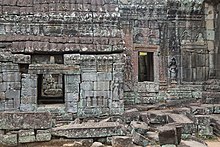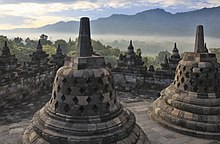
Back بناء بالحجارة Arabic Каменоделство Bulgarian Kamenictví Czech Steinmetz German Cantería Spanish Hargintza Basque بنایی سنگی Persian Taille de pierre French Cantaría Galician בנייה באבן HE
This article needs additional citations for verification. (April 2008) |






Stonemasonry or stonecraft is the creation of buildings, structures, and sculpture using stone as the primary material. Stonemasonry is the craft of shaping and arranging stones, often together with mortar and even the ancient lime mortar, to wall or cover formed structures.
The basic tools, methods and skills of the banker mason have existed as a trade for thousands of years. It is one of the oldest activities and professions in human history. Many of the long-lasting, ancient shelters, temples, monuments, artifacts, fortifications, roads, bridges, and entire cities were built of stone. Famous works of stonemasonry include Göbekli Tepe, the Egyptian pyramids, the Taj Mahal, Cusco's Incan Wall, Taqwesan, Easter Island's statues, Angkor Wat, Borobudur, Tihuanaco, Tenochtitlan, Persepolis, the Parthenon, Stonehenge, the Great Wall of China, the Mesoamerican pyramids, Chartres Cathedral, and the Stari Most.
While stone was important traditionally, it fell out of use in the modern era, in favor of brick and steel-reinforced concrete. This is despite the advantages of stone over concrete. Those advantages include:
- many types of stone are stronger than concrete in compression;
- stone uses much less energy to produce, and hence its production emits less carbon dioxide than either brick or concrete;
- stone is widely considered aesthetically pleasing, while concrete is often painted or clad.
Modern stonemasonry is in the process of reinventing itself for automation, modern load-bearing stone construction, innovative reinforcement techniques, and integration with other sustainable materials, like engineered wood.